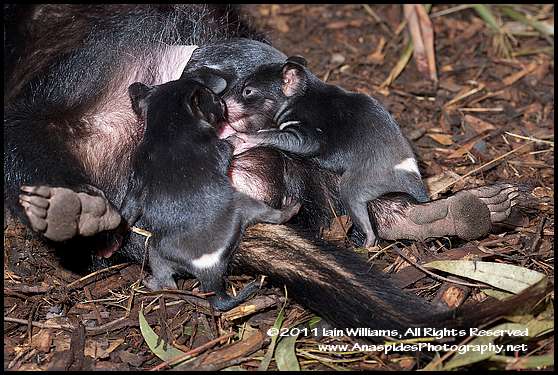Tasmanian Devil Babies - Tasmania
 Friday, August 19, 2011 at 10:45PM
Friday, August 19, 2011 at 10:45PM  During June and July the female Tasmanian Devils (Sarcophilus harrisii ) aren't very active and finding them can be difficult. The reason for their slumber is that most are heavily pregnant or have given birth to young. Amazingly up to 50 young can be born and the joeys must race a distance of about 3 inches (7.6 centimeters) from the birth canal to the mother’s rear-facing pouch, where they compete to attach themselves to one of only four available teats. Only those four will then have a chance to grow and survive.
During June and July the female Tasmanian Devils (Sarcophilus harrisii ) aren't very active and finding them can be difficult. The reason for their slumber is that most are heavily pregnant or have given birth to young. Amazingly up to 50 young can be born and the joeys must race a distance of about 3 inches (7.6 centimeters) from the birth canal to the mother’s rear-facing pouch, where they compete to attach themselves to one of only four available teats. Only those four will then have a chance to grow and survive.
LEFT: A female Tasmania Devil ((Sarcophilus harrisii) rests on her back revealing three large joeys.
 August is the time when the devils are beginning to develop fur and their eyes are opening; for the most part the joeys are still attached to the teats. At this stage of development, the youngsters are growing rapidly and depending upon the number of young in the pouch, it maybe difficult for the mother devil to accommodate them all. The mother devil will scavenge and hunt prey during this time while carrying the babies in the rear-facing pouch attached to her nipples.
August is the time when the devils are beginning to develop fur and their eyes are opening; for the most part the joeys are still attached to the teats. At this stage of development, the youngsters are growing rapidly and depending upon the number of young in the pouch, it maybe difficult for the mother devil to accommodate them all. The mother devil will scavenge and hunt prey during this time while carrying the babies in the rear-facing pouch attached to her nipples.
LEFT: A large heathy male devil baby, guard hairs reflecting in the sun, suckles.
During this time, mother devils attempt to keep beneath the radar as much as possible, as protecting their infants is their prime responsibility and concern. Other devils (male and female) but particularly male devils may try and kill the youngsters The reasons for this are varied but include :protecting food resources (less food to share), reducing rival male devil's DNA by killing the rival's young, and causing the female to become receptive again.
When the young finally are too large, they emerge from the pouch and often ride on their mother’s back, like young koalas or possums, or are dragged along underneath her, still attached to her nipples. After about six months, the young are weaned, leaving the mother to live alone in the bush by late December until the following march when courtship and mating begins again.
To read more articles concerning Tasmanian devils.



